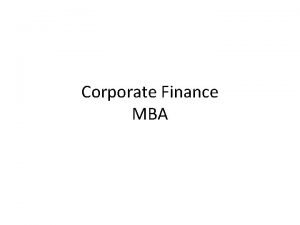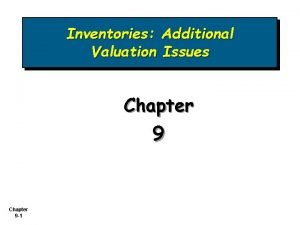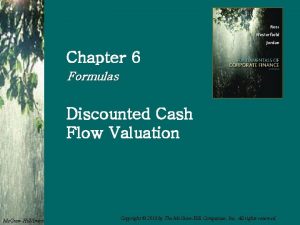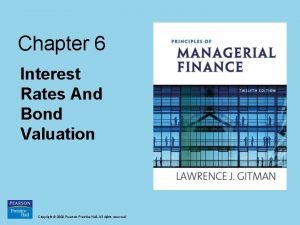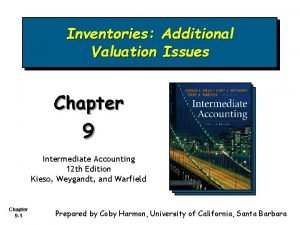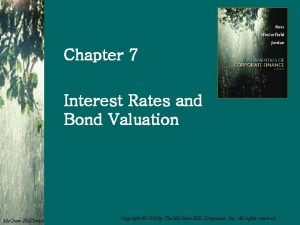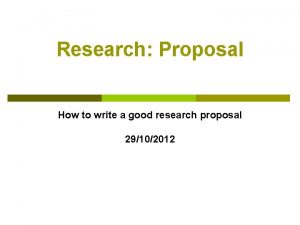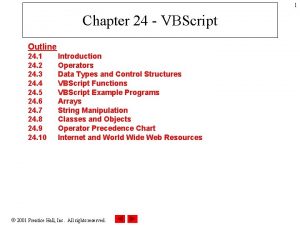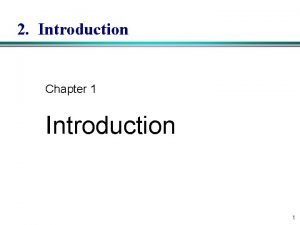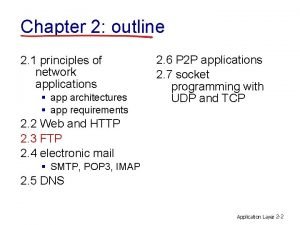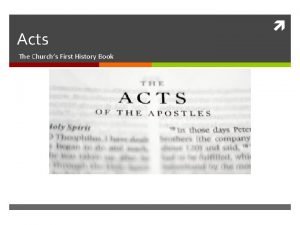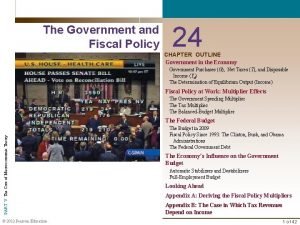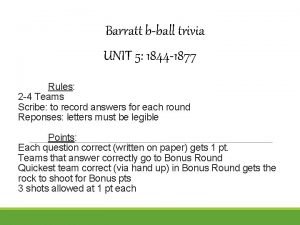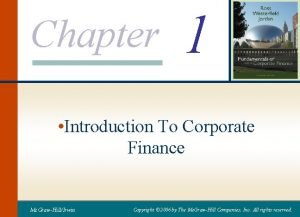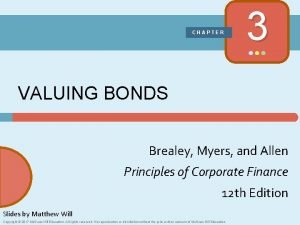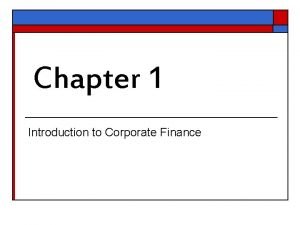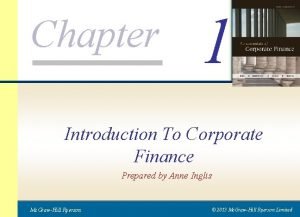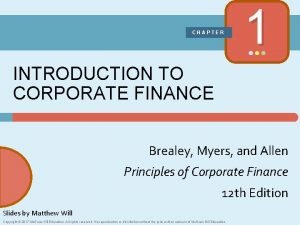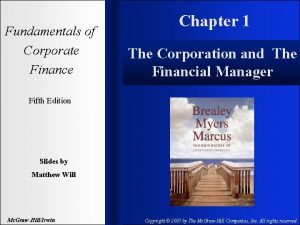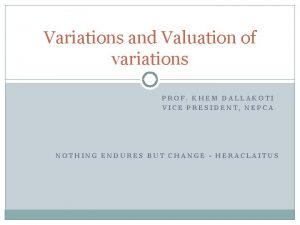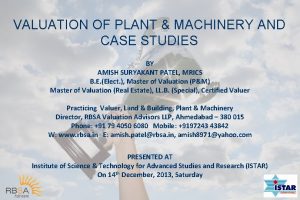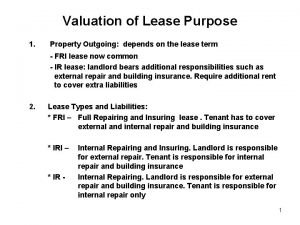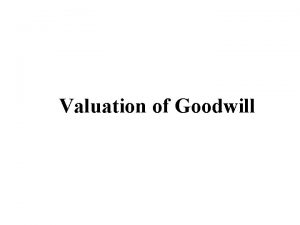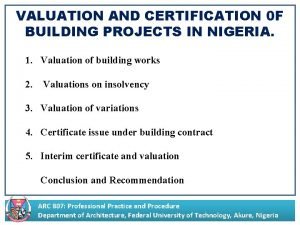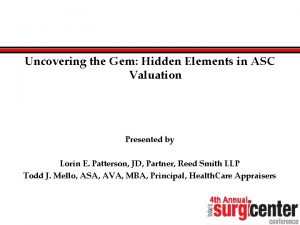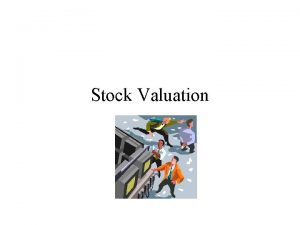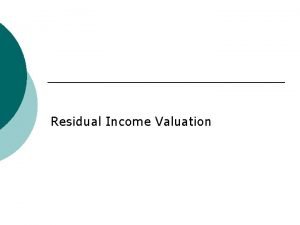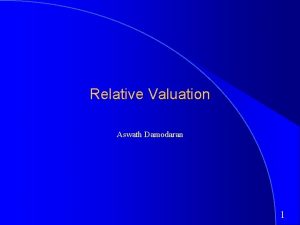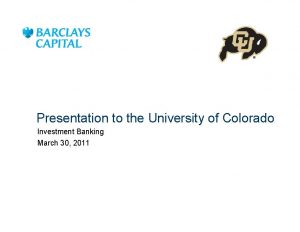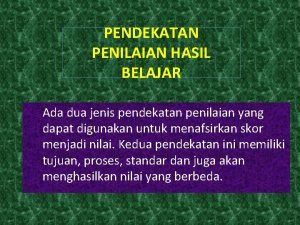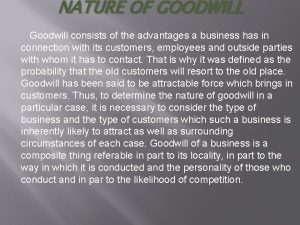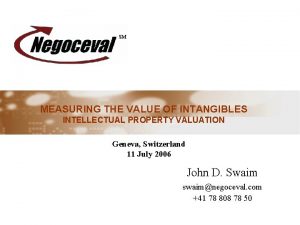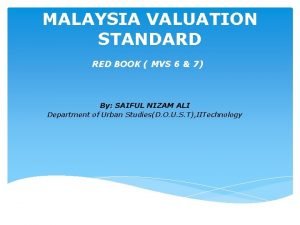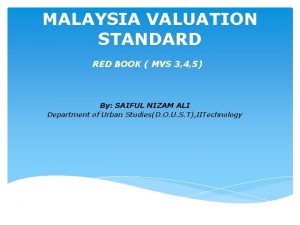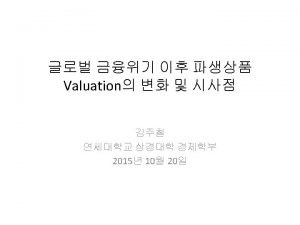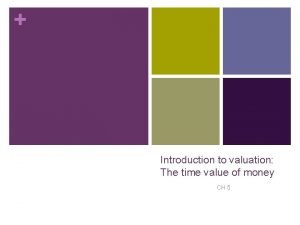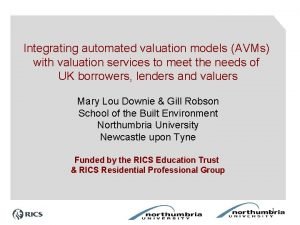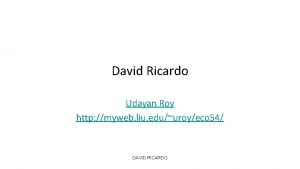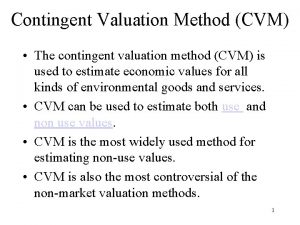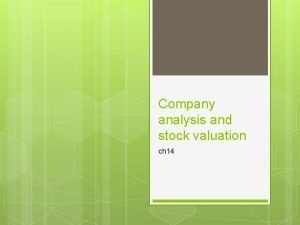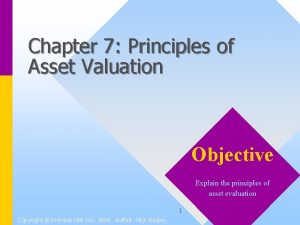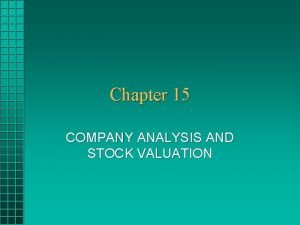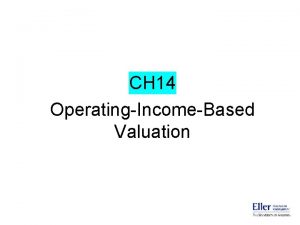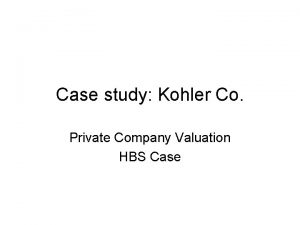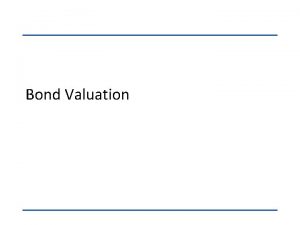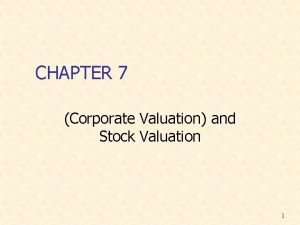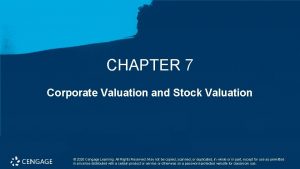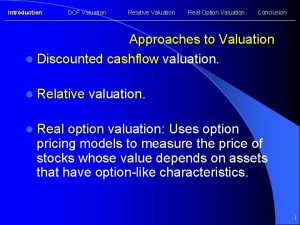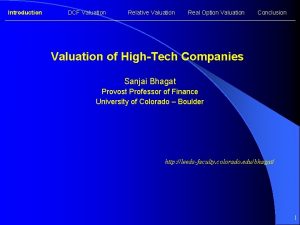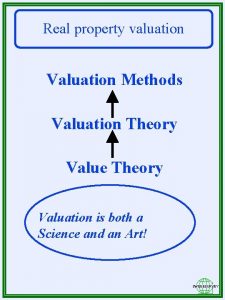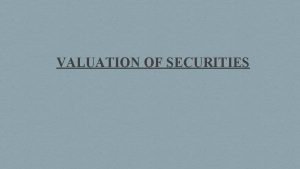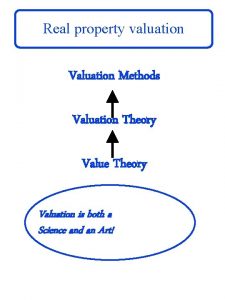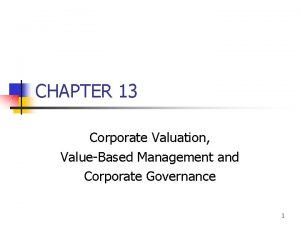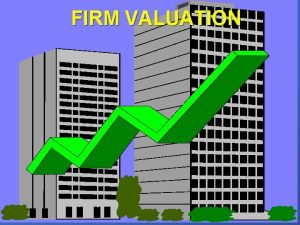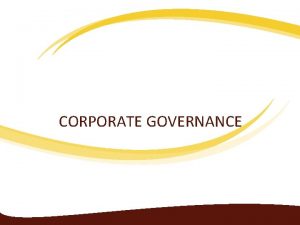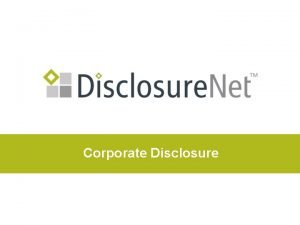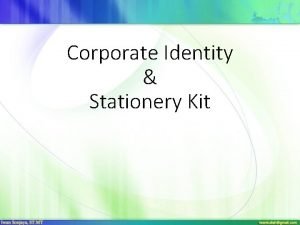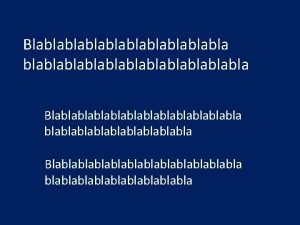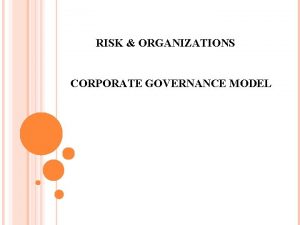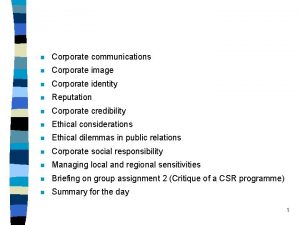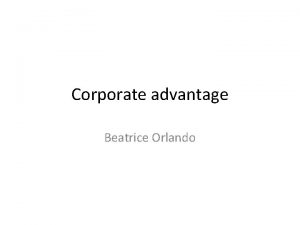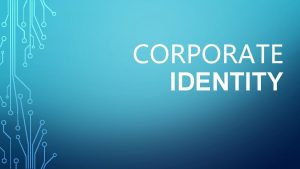Corporate Valuation Chapter 1 Corporate Valuation Primer Outline

















































































- Slides: 81

Corporate Valuation Chapter 1: Corporate Valuation: Primer

Outline • Approaches to Valuation • FCFE and FCFE • Enterprise DCF Valuation • Intangible Valuation

Corporate Valuation • A corporate valuation is a general process of determining the economic value of a whole business or company unit. • Corporate valuation can be used to determine the fair value of a business for a variety of reasons, including sale value, establishing partner ownership, taxation, and even divorce proceedings. • Several methods of valuing a business exist, such as looking at its market cap, earnings multipliers, or book value, among others.

Corporate Valuation Purposes • Shareholder Disputes • Divorce • Mergers, Acquisitions, and Sales • Buy-Sell Agreements- Partnership • Financing • Purchase price allocation - tangible and intangible assets.

Approaches to Valuation • Book Value Approach • Stock and Debt Approach • Discounted Cash Flow Approach • Relative Valuation Approach • Option Valuation Approach

Book Value Approach • Valuing a company based on the information found on its Balance Sheet • Example: Book Value of Assets = Book Value of Investor Claims • BV’s are adjusted to reflect replacement value or liquidation value/ fair value • BV < MV , it means Market Value should be higher • Divergence between BV and MV is • More intangible – Sectors like IT and Pharma • Less in tangible – Real Estate and Banking

Stock and Debt Approach • Value can be obtained by adding the market value of all outstanding securities • Referred as the Market approach • Vf = Ve + Vd • Example: Outstanding Shares of a Company on 31 st March, 2 x 18 is 1. 5 Crores; Closing Price – Rs. 20 on that day. • Outstanding Debt is Rs. 21 Crore. Adding the market value of equity to the market value of debt, the Total Value of Firm is Rs. 51 Crore.

Stock and Debt Approach • This method assumes market efficiency. • Estimate unbiased Intrinsic Value over security • Errors in the market price are unbiased • Price deviations are random and uncontrolled with any observable variable. • Cost of Equity & Cost of Debt

Discounted Cash Flow Approach • Similar to valuing a capital project using the NPV • Forecasting future cash flows and discounting present point of time • Models of DCF: • Enterprise DCF model • Equity DCF Model • Adjusted PV Model • Economic Profit Model

Discounted Cash Flow Approach • Enterprise DCF model – Forecasting the Free Cash Flow to the firm(FCFF) and discounting the same at the weighted average cost of capital(WACC). • FCFF represents the cash flow available for distribution to all investors after CAPEX & WC need. • Equity DCF Model – Focuses on the valuation of firm’s equity. • Dividend discount model (DDM) and Free Cash Flow to Equity Model (FCFE)

Discounted Cash Flow Approach • Adjusted PV Model – Enterprise value as sum of unlevered equity free cash flow and financing side effects – PV of the debt financing (includes Cost of debt, interest rate and tax rate) • Economic Profit Model – Surplus left after making an appropriate charges for the capital invested in business. • Net Operating Profit After Taxes (NOPAT) - Invested Capital * Weighted Average Cost of Capital (WACC)

• Corporate valuation is a process of determining the economic value of the Whole Company • Merger and acquisition is the one among the purpose of corporate valuation • Valuing a company based on the information found from balance sheet is known as Book Value Approach • Market approach is the alternate term for stock and debt approach.

• Outstanding shares of X Limited is 2500 and closing price is Rs. 18 on that day. Outstanding debt is Rs. 3850. How much is the total value of firm on that based on stock and debt approach? • ANS: 48850 • Equity DCF model is focuses on the valuation of firm’s equity. • Adjusted PV model is focuses on the valuation of unlevered equity free cash flows.

Discounted Cash Flow Approach • FCF: Free cash flow refers to the cash available to investors after paying for operating and investing expenditure. • The two types of free cash flow measures used in valuation are: FCFF & FCFE. • Usually, when we talk about free cash flow we are referring to FCFF.

Discounted Cash Flow Approach • FCFF: The cash flows before debt payments and after reinvestment needs are called free cash flows to the firm • The discount rate that reflects the composite cost of financing [Debt + Equity] from all sources of capital is called the WACC. • It is normally more than FCFE. It can be equal to the FCFE if the firm has no debt. • The free cash flow to the firm is a pre-debt but post-tax CF. • FCFF = Net Income + Amortizations + Interest (1 – T) + Depn – Capex – ∆ WC [+ if Decrease] • FCFF = EBIT (1 – T) + Amortizations + Dep – Capex – ∆ WC • FCFF = Cash flow from operations + Interest (1 – T) – Capex • FCFF = FCFE + Interest (1 – T) – New Debt Issues + Principal Repayments

Discounted Cash Flow Approach • FCFE: The cash flows after debt payments and reinvestment needs are called free cash flows to equity, and the discount rate that reflects just the cost of equity financing is the cost of equity. • It is available only to equity holders of a company. • The FCFE can be negative for companies, which either have negative net income and/or high capital expenditures, relative to depreciation. • FCFE = Net Income – Pref. dividend + Amortizations + Depn – Capex – ∆ WC + (new debts – debts repayments) + New Preference Issue – Preference repayment • FCFE = FCFF – Interest (1 – T) + Net Borrowing.

Discounted Cash Flow Approach FCFF FCFE It is available to all investors of the firm It is available to Equity investors only Excludes impact of leverage & hence called unlevered CF Includes impact of leverage by subtracting interest and repay to debt holders and called levered CF Computes Enterprise Value Computes Equity Value WACC is base for PV computation Ke is base for PV computation

• The cash flows before debt payments and after reinvestment need are called Free Cash Flow to Firm. • The Free cash flow to equity can be negative for companies, which either have negative net income or High capital expenditures. • WACC is the base for Present value computation under free cash flow to firm.

FCFE and FCFF • The financial information's extracted from Leopard Steel Limited as on 31. 3. 2018: (Rupees in Crore) • EBITDA – Rs. 1000 • Depreciation – Rs. 400 • Interest Expenses – Rs. 150 • Tax Rate – 30% • Purchase of Fixed Assets – Rs. 500 • Changes in Working Capital – Rs. 50 • Net Borrowings – Rs. 80 • Common Dividends – Rs. 200 Required to Calculate FCFF and FCFE for Leopard Steel Limited

FCFE and FCFF • Solution: FCFF using Net Income Approach • NI = (EBITDA – Depreciation – Interest) (1 - Tax rate) • NI = (1000 -400 -150) (1 -30%) = 315 • FCFF = NI + NCC + Interest(1 -Tax Rate) – FCInv - ∆ WC • FCFF = 315+400+150(1 -30%)-500 -50 = 270

FCFE and FCFF • Solution: FCFF using EBIT and EBITDA • EBIT = EBITDA – Dep = 1000 – 400 = 600 • FCFF = EBIT(1 -t)+Dep-FCInv - ∆ WC • FCFF = 600(1 - 30%) + 400 – 50 = 270 • FCFF = EBITDA(1 -t)+Dep(t)-FCInv-∆ WC • FCFF=1000(1 -30%)+400(30%)-500 -50 = 270

FCFE and FCFF • Solution: FCFF using CFO • CFO = NI + Dep - ∆ WC • CFO = 315 +400 -50 = 665 • FCFF = CFO +Int(1 -t)– FCInv • FCFF = 665+150(1 -30%)-500 = 270

FCFE and FCFF • Solution: FCFE using FCFF, Net Income and CFO • FCFE = FCFF – Int (1 -t) + Net Borrowing • FCFE = 270 -150 (1 -30%) +80 = 245 • FCFE = NI + NCC-FCInv – WCInv + Net Borrowing • FCFE = 315 + 400 – 500 -50 + 80 = 245 • FCFE = CFO – FCInv + Net Borrowing • FCFE = 665 – 500 + 80 = 245

FCFE and FCFF • The following financial informations extracted from the Tata Steel and JSW Steel for the year ended 31 March 2018. Particulars Tata Steel (Rs. in Crore) JSW Steel (Rs. in Crore) Net Sales 38199 46221 EBITDA 11353 13492 Depreciation 1640 2291 Finance Cost 1877 3097 Tax Rate 30% 27% Capex 9279 8751 Changes in Working Capital 2278 1254 Borrowings 25911 48711 • Required: Calculate FCFF and FCFE

FCFE and FCFF Answer:

• EBITDA is Rs. 2500, Depreciation is Rs. 300, Finance cost is Rs. 200 and Tax rate is 30%. Find out Net Income. • ANS: 1400 • The net income of firm is Rs. 3000, depreciation is Rs. 300, finance cost is Rs. 300, purchase of fixed assets is Rs. 750 and changes in working capital is Rs. 200. Tax rate is 25% Find out Free Cash Flow to Firm. • ANS: 2575 • Cash flow from operations is Rs. 3525, purchase of fixed assets is Rs. 825 and Net borrowings is Rs. 200, the tax rate is 30%. Find out Free Cash Flow to Equity. • ANS: 2900

Mr. Anand, Financial Analyst, is analyzing the financial statements of MRF Limited. He has a 2018 income statement and balance sheet, as well as 2019 income statement, balance sheet, and cash flow from operations forecasts (as shown below in the tables below). Assume there will be no sales of long-term assets in 2019.

FCFF and FCFE • Solution: • Fixed Capital Investment = 400 – 300 = 100 • Working Capital Investment = (Accts Rec 2019 + Inv 2019 - Accts. Pay 2019) – (Accts Rec 2018 + Inv 2018 - Accts. Pay 2018) • WCInv = (30+40 -20) – (15+30 -20) = 25 • FCFF = NI + NCC + [Int x (1 - tax rate)] – FCInv – WCInv • = 56+50+[15 x (1 -30%)] – 100 – 25 • = - 8. 5 • FCFF can be negative in the short term. • FCFE = FCFF – [Int x (1 – taxrate)] + net borrowing • = - 8. 5 – 10. 5 + 24 = 5

FCFE and FCFF • FCFE = Net Income + Dep – Capex – Change in WC (or) • FCFE = CFO – FCInv + Net Borrowing • FCFF = FCFE - Int(1 – T) – New Debt issues + Debt repay

FCFE and FCFF • Diebold Incorporated manufactures, markets, and services automated teller machines in the United States. The following are selected numbers from the financial statements for 2018 and 2019 (in Crores): Revenues (Less) Operating Expenses (Less) Depreciation = Earnings before Interest and Taxes (Less) Interest Expenses (Less) Taxes = Net Income Working Capital 2018 544. 0 (465. 1) (12. 5) 2019 620. 0 (528. 5) (14. 0) 66. 4 77. 5 (0. 0) (25. 3) 41. 1 175. 0 (0. 0) (29. 5) 48. 0 240. 0 • The firm had capital expenditures of 15 Crore in 2018 and 18 Crore in 2019. The WC in 2017 was 180 Crore. • Required: (a) FCFE for 2018 and 2019 (b) Find FCFF for 2018 and explain the difference between FCFF and FCFE if any with reasons.

FCFE and FCFF • Solution: (a) FCFE in 2018 = Net Income + Dep – Capex – Change in WC = 41. 10 + 12. 50 – 15 – (175 – 180) = 43. 60 Crore FCFE in 2019 = 48 + 14 – 18 – (240 – 175) = – 21 Crore • (b) w. k. t. FCFF = FCFE - Int (1 – T) – New Debt issues + Debt repay • = 43. 60 Crore - Nil – Nil + Nil = 43. 60 Crore • As there is no interest on debt, debt capital is nil and no data on any debt inflow or outflow & hence FCFF = FCFE.

FCFE and FCFF • Zuari Agro Chemicals Ltd produces fertilizer and agricultural chemicals from its operations in India, Sri Lanka, South Africa and Bangladesh, which it sells globally. The following table shows financial information for the company. Particulars Net Income Cash Flow from Operations FCInv (Capital expenditures) Net Borrowings Interest Debt repayment Tax 2017 2018 2079 3225 2133 3251 12% 487 30% 1785 3212 1624 2874 13. 5% 584 27% • Required: (i). Calculate FCFE (Use CFO Approach) and (ii). FCFF using FCFE

FCFE and FCFF Solution: FCFE = CFO - FCInv + NB =3225 -2133+3251 =3212 -1624+2874 4343 4462 273 283 =4343 -273 -0+487 =4462 -283 -0+584 4557 4763 FCFE FCFF = FCFE - Int (1 -t)-New Debt + Debt repay Int(1 -t) FCFF

Present Value of FCFE and FCFF • (a) Value of Equity = • (b) Value of Firm =

Present Value of FCFE and FCFF The following are the projected cash flows to equity and to the firm over the next five years: Year 1 2 3 4 5 Terminal Value CF to Equity 250. 00 262. 50 275. 63 289. 41 303. 88 3, 946. 50 Int (1 -t) 90. 00 94. 50 99. 23 104. 19 109. 40 CF to Firm 340. 00 357. 00 374. 85 393. 59 413. 27 6, 000. 00 (The terminal value is the value of the equity or firm at the end of year 5. ) The firm has a cost of equity of 12% and a cost of capital of 9. 94%. Required: (a) What is the value of the equity in this firm? (b) What is the value of the firm?

Present Value of FCFE and FCFF • Solution: • (a) Value of Equity = • Value of Equity = 250/1. 12 + 262. 50/1. 122 + 275. 63/1. 123 + 289. 41/1. 124 + (303. 88+3946. 50)/1. 125 = 3224 • (b) Value of Firm = • FCFF = 340/1. 0994 + 357/1. 09942 + 374. 85/1. 09943+393. 59/1. 09944+ (413. 27+6000)/1. 09945 = $5149

Present Value of FCFE and FCFF • Cipla Limited FCFF of Rs. 700 and FCFE of Rs. 620. Cipla’s beforetax cost of debt is 5. 7 %, and its required rate of return for equity is 11. 8 %. The company expects a target capital structure consisting of 20 % debt financing and 80 % equity financing. • • The tax rate is 33. 33 %, and FCFF is expected to grow forever at 5. %. Cipla Limited has debt outstanding with a market value of Rs. 220 and has 200 outstanding common shares. • 1 What is Cipla Limited’s weighted average cost of capital? • 2 What is the value of Cipla Limited’s equity using the FCFF valuation approach? • 3 What is the value per share using this FCFF approach?

Present Value of FCFE and FCFF •

Present Value of FCFE and FCFF • Solution to 3: • Dividing Rs. 11, 934. 6 by the number of outstanding shares gives the • estimated value per share, V 0: • V 0 = Rs. 11, 934. 6 /200 shares = Rs. 59. 67 per share

Present Value of FCFE and FCFF • An Analyst wants to estimate the value of Star Manufacturers’ stock. He gathers the following information about the company: • FCFF at the end of 2019 – Rs. 660 Crore • Before tax Cost of Debt – 4. 5% • Required rate of return on equity – 11% • Target debt to equity ratio – 0. 4 • Number of common shares outstanding – 300 • Expected long-term growth rate in FCFF – 5% • Tax rate – 40 % • Market Value of debt = Rs. 1200 Crore • 1. Calculate WACC • 2. What is the intrinsic Value of the Company’s Stock at the end of 2019.

Horizon Valuation • Determine value of business at horizon • Business often assumed to be either stable going concern or steadily growing business • Stable (no growth) future: use perpetuity formula PVH at horizon = (CFH+1)/r Horizon Value • Constant growth future: use growing perpetuity formula PVH at horizon = (CFH+1)/(r-g) Horizon Value • Discount horizon value to determine PV PVH at year 0 = (CFH+1)/(r-g) * (1/1+r)H PV(Horizon Value)

Case Study • Televista Corporation is expected to grow at a higher rate for 4 years, thereafter the growth rate will fall and stabilize at a lower level. The following information is available: Base Year (Year 0) Data Revenues Rs. 1, 600 million EBIT Rs. 240 million Capex Rs. 200 million Depreciation Rs. 120 million WC as a percentage of revenues 25 % Corporate tax rate 35 % Paid up equity capital (Rs. 10/share) Rs. 180 million Market Value of Debt Rs. 600 million

Case Study Inputs for the High Growth Period Length of high growth period 4 years Growth rate in revenues, 20 % depreciation, EBIT and Capex WC as a percentage of 25 % revenues Cost of Debt 15 % Debt-Equity Ratio 1. 50 : 1 Risk free rate 12 % Market risk premium 7% Equity Beta 1. 25 Required: (a) Find the FCFF (b) Find the value of the firm Inputs for the Stable Growth Period Expected Growth rate in revenues & EBIT 10 % WC as a percentage of revenues 25 % 14 % (pre. Cost of Debt tax) Debt-Equity Ratio 1: 1 Risk free rate 12 % Market risk premium 6% Equity Beta 1. 00

Relative Valuation

Relative Valuation • This approach involves valuing a company by comparing it with the valuation of other companies in the same industry. • Also referred to as the direct comparison approach or the multiples approach • This comparison is done using two approaches : (a) Comparison with industry averages (b) Comparison with comparable companies

Relative Valuation • Two kinds of Multiples in Relative Valuation • A) Enterprise Multiples • It expresses the value of the company or enterprise value (EV), in relation to the whole company. • The Most common enterprise multiples are • EV/EBITDA • EV/BV and • EV/S • B) Equity Multiples • It expresses the value of equity in relation to an equity static • The most common equity multiples are: • P/E and Price per share/Book Value

Relative Valuation Issues with Relative Valuation • Relative valuation approach does not give an exact result (unlike discounted cash flow) • Simplistic – deals with single number – High possibility for erroneous and interpretation • Static – Fails to capture the nature of business and competition • Difficult to compare – Many multiples may differ • Peer Selection – Companies must be similar

• Relative Valuation approach involves valuing a company by comparing it with the valuation of other companies in the same industry. • Relative valuation approach is deals with single number, there will be High possibility for erroneous and interpretation.

Option Valuation

Option Valuation • It is special contract under which the option owner enjoys the right to buy or sell without obligation. • Option pricing valuation is actually a kind of absolute valuation • It derives asset value based on the risk and return of the asset (the option) • Financial option • Real option

Intangibles Valuation

Intangibles Valuation • Intangible asset is that it is an asset that we can neither see nor feel. • Broad range of intangible assets: • Franchises, copy rights and trademarks • Patents • Brand names • Goodwill • Invisible assets including: • Top-notch management • Loyal and well-trained workforce • Technological know-how

Intangibles Valuation • The needs for intangible assets are : • i) Business Value addition • ii) Distinguish product from similar products • iii) Improve Value for Stake holders • iv) Create a Business Image

Process of Valuation of Intangible Assets • Valuation of intangible assets is a complex exercise. • The non-physical form of intangible assets makes it difficult to identify the future economic benefits that the enterprise can expect to derive from the intangible assets. • Many intangible assets do not have alternative use and cannot be broken down into components or parts for resale. • There are three approaches used in valuing intangible assets: • (i) Cost approach, • (ii) Market value approach and • (iii) Economic value approach.

Intangibles Valuation • Valuation of Goodwill • Valuation of Brand • Trademarks • Patents • Royalty • Copy rights etc. • Let’s see Valuation of Goodwill and Brand Valuation

Valuation of Goodwill • Goodwill is the value of the reputation of a firm built over time with respect to the expected future profits over and above the normal profits. • Goodwill is an intangible real asset which cannot be seen or felt but exists in reality and can be bought and sold. • Valuation of Goodwill: • Average Profit method • Super Profit method • Capitalization method

Valuation of Goodwill • Average Profit Method • In this method, the profits of the past few years are averaged and adjusted for any change that is expected to occur in the near future. • The adjusted average is multiplied by a certain number (say, 2 or 3 or 5) as agreed. • Good Will = Average Profit x No. of years of Purchase

Valuation of Goodwill • Average Profit Method – Example 1 • It is expressed, for example, as 3 years’ purchase of five years’ average profits. If, for example, the profits for the last five years have been Rs 80, 000, Rs 90, 000, Rs 70, 000 Rs 85, 000 and Rs 1, 000; the average yearly profit comes to • If, goodwill is to be valued at 3 years’ purchase of average profits for. 5 years, goodwill be Rs 85, 000 x 3 = Rs 2, 55, 000.

Valuation of Goodwill • Average Profit Method – Example 2 • Majumdar & Co. decides to purchase the business of ABC Ltd. on 31. 12. 2003. • Profits for the last 6 years were: 1998 Rs. 10, 000; 1999 Rs. 8, 000; 2000 Rs. 12, 000; 2001 Rs. 16, 000, 2002 Rs. 25, 000 and 2003 Rs. 31, 000. • Compute the value of Goodwill on the basis of 3 years’ purchase of the average profit for the last 4 years. • Solution • Average Profit for last 4 year = 12000+16000 + 25000+31000/4 • = 21000 • Therefore Goodwill = 21000 * 3 = 63, 000

Valuation of Goodwill • Super Profit Method • In every industry, there is a rate which is considered to be the normal rate at which profits are expected to the earned on capital employed. • If a firm is able to earn more than the normal expected profit, the excess is called super profits which can be attributed to the special advantages of firm. • Normal Profit = Capital Employed x Normal Rate of Return • Super Profit = Actual Profit/Average Profit – Normal Profit • Goodwill = Super Profit x No. of years of Purchase

Valuation of Goodwill • Super Profit Method – Example 1 • The capital of the firm is Rs 4, 000 and that 15% is reasonable return in the industry. If the average profits are Rs 85, 000. Calculate goodwill value for 3 years’ purchase agreed upon. • Solution: • Normal Profit = 400000 x 15% = 60000 • Super Profit = 85000 – 60000 = 25000 • Goodwill = Rs. 25, 000 x 3 • = Rs. 75, 000

Valuation of Goodwill • Super Profit Method – Example 2 • ABC Limited earns a profit of Rs. 50, 000 by employing a capital of Rs. 2, 000, The normal rate of return of a firm is 20 %. 5 years agreed to purchase. • Calculate value of Goodwill using super profit method. • Solution: • Normal Profit = 2, 000 x 20/100 = Rs. 40, 000 • Super Profit = Rs. 50, 000 – Rs. 40, 000 = Rs. 10, 000 • Goodwill = Rs. 10, 000 x 5 = Rs. 50, 000

Valuation of Goodwill • Capitalisation Method • In this method, the value of the whole business is found out by the formula, • The net assets (excluding goodwill) of the firm are deducted and the remainder is goodwill. • Capitalized Value of Profit = Actual Profit x 100/NRR • Net Assets = Total Assets – Outsiders Liabilities • Goodwill = Capitalized Value of Profit – Net Assets

Valuation of Goodwill • Capitalisation Method – Example 1 • The capital of the firm is Rs 4, 40, 000 and that 15% is reasonable return in the industry. The reasonable or normal profits are Rs 60, 000. If the average profits are Rs 85, 000, Total assets (excluding goodwill) or capital is Rs 4, 40, 000 and Creditors is 40000. Calculate Value of Goodwill. • Solution: • Capitalized Value of Profit = Average/Actual Profit x 100/NRR = 85000 x 100/15 = 5, 667 • Net Assets = Rs. 4, 40, 000 – Rs. 40, 000 = Rs. 4, 000 • Goodwill = 5, 667 – 4, 000 = 1, 667

Valuation of Goodwill • Capitalisation Method – Example 2 • A firm earns profits of Rs. 2, 000. The normal rate of return in a similar type of business is 10% on total assets (excluding goodwill) and total outsiders’ liabilities as on that of valuation of goodwill are Rs. 22, 000 and Rs. 5, 60, 000 respectively. • Calculate the value of goodwill using Capitalisation method.

Valuation of Goodwill • Capitalisation Method – Example 2 • Solution • Average Profits = 2, 000 • Capitalizes Value of Average Profits = 2, 000 * 100/10 • = 20, 000 • Net Assets = Total Assets – Outsiders’ Liabilities • = 22, 000 -560000 = 16, 40, 000 • Therefore Good will = 20, 000 -16, 40, 000 = 3, 60, 000

Brand Valuation • Brand valuation is a process to ascertain the value of a brand. The value of a brand depends on the corporate’s philosophy, culture, positioning, messages, promises, deliverables, legal protection and value proposition. • Approaches for determining the financial value of a brand: • The cost approach • The market approach using DCF method • Multiple or number of years of profits method.

Brand Valuation • Brand valuation is needed for : • (i) Accounting purpose • (ii) Transactional purposes • (iii) Brand management purposes

Brand Valuation • Various companies find brand valuation helpful for the followings: • (i) Making decisions on business investments • (ii) Measuring the return on brand investment based on brand value to arrive at an ROI that can be directly compared with other investments. • (iii) Allocating marketing expenditures according to the benefit each business unit derives from the brand asset. • (iv) Organizing and optimizing the use of different brands in the business • (v) Determining brand royalty rates for optimal exploitation • (vi) Tracking brand value management.

Brand Valuation • Multiple or number of years of profits method: Step 1: Weighted Average Earnings Before Tax Particulars Year 1 Year 2 Year 3 1 2 3 EBIT Add: Non-operating Expenses Less: Non-operating Incomes Brand Earnings Inflation Adjusted compounded Brand Earnings Weights Products (Inflation Adjusted Value x Weights)

Brand Valuation • Multiple or number of years of profits method: Step 2: Brand Value Particulars Weighted Average Earnings Before Tax (Sum of Products / Sum of Weights) Less: Remuneration of Capital Less: Taxes Weighted Average Earnings After Tax Capitalization Factor Brand Value = Weighted Average Earnings after tax x Capitalization factor Rs.

Brand Valuation 1. RS Ltd furnishes the following information relating to the previous three years, and requests you to compute the value of the brand of the Company — [Rs` in Lakhs] Particulars Profits Before Interest and Tax Loss on Sale of Assets Non Operating Income 2011 75. 00 3. 00 12. 00 2012 85. 25 --7. 25 2013 150. 00 18. 00 • Inflation was 9% for 2012 and 15% for 2013. If the capitalization factor considering internal and external value drivers to the brand is 14, determine the brand value. Assume an all inclusive future tax rate of 35%.

Brand Valuation 2. The following financial share date pertaining to TECHNO LTD an IT company is made available to you : Year ended March 31 st EBIT (Rs) Non-branded Income (Rs) Inflation compound factor @ 8% Remuneration of Capital Average capital Employed (Rs) Corporate Tax Rate Capitalization Factor 2014 696. 03 53. 43 1. 000 5% of average capital employed 1112. 00 35% 16% 2013 325. 65 35. 23 1. 087 • You are required to calculate the Brand Value for Techno Ltd. 2012 155. 86 3. 46 1. 181

Brand Valuation • Problem No. 3 • Agile Limited is a manufacturer-cum-dealer of 'R Tuff’ brand of trousers. With passage of time, its brand has been well accepted in the market. The company has been approached by a foreign company engaged in the same trade to enter as partner in its business. Agile, in order to negotiate the deal wants to get its brand valued. The following information based on market research is available: • (i) Garment industry of which Agile is a constituent, is expected to grow by 9% per annum during the next five years. The present market size of the industry is Rs. 7, 500 crores.

Brand Valuation • Problem No. 3 • (ii) There are other brands both national and international in the market. The existence of duplicate brands is unavoidable. The share of such players is estimated to be 63% of the total industry market. The market share of other national brands will increase @ 0. 25% year on year basis in the next 5 years. The share of international brands is expected to grow 1. 5 times of national brands. But the existence of duplicate brands is to fall by 2. 5% over the period of next 5 years, spread equally. • (iii) The expected foreign partner needs the production line of the company to be re-engineered which will lead to an increase in the yield of the company by 3% after one year over the present yield of 10% followed thereafter by further increase of 5% year on year.

Brand Valuation • Problem No. 3 • Following the market oriented approach, determine the brand value to be used for negotiation with the foreign company, considering the discount factor for 1 st five years as 0. 909; 0. 826; 0. 751; 0. 683 and 0. 621 (Monetary values in crores to be rounded off to nearest 2 decimal places).

Brand Valuation • Problem No. 4 • Sanju Ltd. has hired a Marketing Consultancy Firm for doing market research and provide data relating to Tyre industry for the next 10 years. The following were the observations and projections made by the consultancy firm. • a. The Tyre Industry in the target area i. e. Whole of India, is expected to grow at 5% p. a. for the next 3 years, and thereafter at 7% p. a. over the subsequent seven years. • b. The market size in terms of unencumbered basic sales of Tyres was estimated at Rs. 8, 000 Lakhs in the last year, dominated by medium and large players. This includes roughly 9. 0% of fake brands and locally manufactured Tyres. Market share of this segment is expected to increase by 0. 5%.

Brand Valuation • Problem No. 4 • c. Cheap Chinese imports accounts for 40% of the business (but 60% of the volume). This is expected to increase by 0. 25% p. a. over the next decade. • d. The other large players account for roughly 35% of the business value, which is expected to go down by 0. 5% p. a. over the next ten years, due to expansion of Sanju Ltd. ’s product portfolio. • e. The Company is in the process of business re-engineering, which will start yielding results in 2 years’ time, and increase its profitability by 3% from its existing 12%. • If the appropriate discount rate is 15% what is the Brand Value of Sanju Ltd. , under Market Oriented Approach?

Brand Valuation • Problem No. 5 • It is estimated that a home grown brand in telecom sector would yield a revenue of Rs. 125 mn. in the initial year end and it would grow a rate of 10%, 8%, 6% for next three years before it finally starts growing at 3% for ever. Find out the Value of Brand as per present value model. The weighted average cost of capital is 11%.

• ABC Limited earns a profit of Rs. 50, 000 by employing a capital of Rs. 2, 000, The normal rate of return of a firm is 20 %. What would be the value of goodwill? • ANS: 50, 000 • The capital of the firm is Rs 4, 000 and that 15% is reasonable return in the industry. The reasonable or normal profits are Rs 60, 000. If the average profits are Rs 85, 000. Calculate goodwill value for 3 years’ purchase agreed upon. • ANS: 75, 000 • The value of goodwill under capitalisation approach is capitalised value of Profits as reduced by net assets. • (Profits/Normal Rate of Return)*100= Capitalised Value of Profits. • Royalty Relief Method is a method of Brand valuation.

Thank you
 Valuation of bonds
Valuation of bonds Corporate valuation model
Corporate valuation model Sandwich in a sentence
Sandwich in a sentence Mba finance course outline
Mba finance course outline Objective of corporate finance
Objective of corporate finance Chapter 7 interest rates and bond valuation
Chapter 7 interest rates and bond valuation Chapter 9 inventories additional valuation issues
Chapter 9 inventories additional valuation issues Chapter 6 discounted cash flow valuation
Chapter 6 discounted cash flow valuation Your uncle would like to restrict his interest rate risk
Your uncle would like to restrict his interest rate risk Chapter 6 interest rates and bond valuation
Chapter 6 interest rates and bond valuation Lower of cost or market rule
Lower of cost or market rule Chapter 7 interest rates and bond valuation
Chapter 7 interest rates and bond valuation Chapter 6 interest rates and bond valuation
Chapter 6 interest rates and bond valuation Labeling theory of deviance examples
Labeling theory of deviance examples Romans outline by chapter
Romans outline by chapter Research proposal components
Research proposal components Chapter 27 give me liberty
Chapter 27 give me liberty Secondary data
Secondary data Chapter 38 a world without borders outline
Chapter 38 a world without borders outline 24 chapter outline
24 chapter outline What is the physical condition of peeta and katniss?
What is the physical condition of peeta and katniss? Chapter 31 societies at crossroads
Chapter 31 societies at crossroads Ap world history chapter 28 outline
Ap world history chapter 28 outline Advantages and disadvantages of sociology
Advantages and disadvantages of sociology Chapter 1 outline
Chapter 1 outline Chapter 1 outline
Chapter 1 outline Agent orange and napalm
Agent orange and napalm Chapter 2 outline
Chapter 2 outline The book of acts outline
The book of acts outline Government spending multiplier
Government spending multiplier 24 chapter outline
24 chapter outline Apush chapter 16 conquering a continent outline
Apush chapter 16 conquering a continent outline Fundamentals of corporate finance chapter 6 solutions
Fundamentals of corporate finance chapter 6 solutions Chapter 1 introduction to corporate finance
Chapter 1 introduction to corporate finance Fundamentals of corporate management
Fundamentals of corporate management Principles of corporate finance chapter 3 solutions
Principles of corporate finance chapter 3 solutions Chapter 5 corporate liquidation and reorganization
Chapter 5 corporate liquidation and reorganization Examples of agency problems
Examples of agency problems Corporate finance chapter 1
Corporate finance chapter 1 Chapter 1 introduction to corporate finance
Chapter 1 introduction to corporate finance Chapter 1 introduction to corporate finance
Chapter 1 introduction to corporate finance Fundamentals of corporate finance, chapter 1
Fundamentals of corporate finance, chapter 1 Valuation of variations
Valuation of variations Machinery valuation report
Machinery valuation report What is outgoings in valuation
What is outgoings in valuation Annuity method of goodwill
Annuity method of goodwill Valuation model of mnc
Valuation model of mnc Building valuation certificate
Building valuation certificate Skillshare valuation
Skillshare valuation Gem asc
Gem asc Generalized dividend valuation model
Generalized dividend valuation model Stock valuation grade 12
Stock valuation grade 12 Contingent valuation method
Contingent valuation method Residual income definition
Residual income definition Damodaran relative valuation
Damodaran relative valuation Football field valuation
Football field valuation Contoh pendekatan hasil
Contoh pendekatan hasil Disadvantages of goodwill
Disadvantages of goodwill Valuing intangible assets
Valuing intangible assets Justified price to earnings
Justified price to earnings Malaysian valuation standards
Malaysian valuation standards Red mvs definition
Red mvs definition General surveying services
General surveying services Credit value adjustment formula
Credit value adjustment formula Introduction to valuation the time value of money
Introduction to valuation the time value of money Contractors method of valuation
Contractors method of valuation Sum-of-the-parts valuation
Sum-of-the-parts valuation Automated valuation service
Automated valuation service Fuze valuation
Fuze valuation Gv roll 2018
Gv roll 2018 Gas station appraisal sample
Gas station appraisal sample Contingent valuation method
Contingent valuation method Myweb valuation
Myweb valuation Contingent valuation example
Contingent valuation example Company analysis stock valuation
Company analysis stock valuation Avco stock valuation
Avco stock valuation 7 principles of valuation
7 principles of valuation Bond price formula
Bond price formula Company analysis and stock valuation
Company analysis and stock valuation Ropi valuation model
Ropi valuation model Kohler co case
Kohler co case Bond future value formula
Bond future value formula



